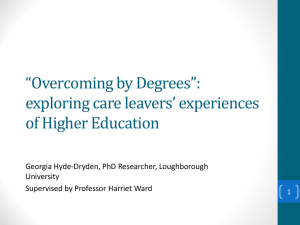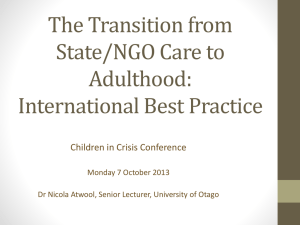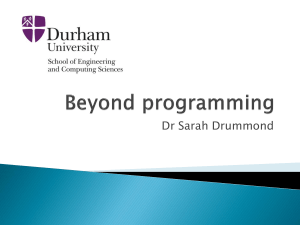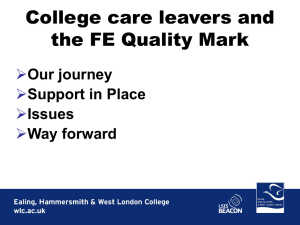Finding their Feet | Executive summary
advertisement
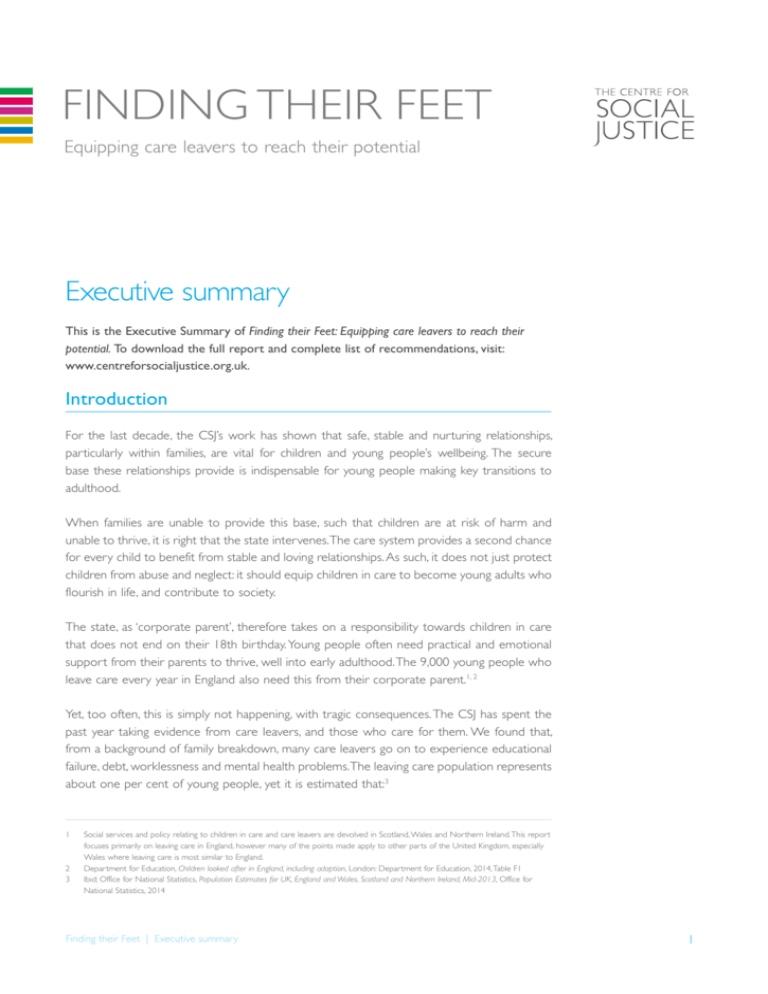
FINDING THEIR FEET Equipping care leavers to reach their potential Executive summary This is the Executive Summary of Finding their Feet: Equipping care leavers to reach their potential. To download the full report and complete list of recommendations, visit: www.centreforsocialjustice.org.uk. Introduction For the last decade, the CSJ’s work has shown that safe, stable and nurturing relationships, particularly within families, are vital for children and young people’s wellbeing. The secure base these relationships provide is indispensable for young people making key transitions to adulthood. When families are unable to provide this base, such that children are at risk of harm and unable to thrive, it is right that the state intervenes. The care system provides a second chance for every child to benefit from stable and loving relationships. As such, it does not just protect children from abuse and neglect: it should equip children in care to become young adults who flourish in life, and contribute to society. The state, as ‘corporate parent’, therefore takes on a responsibility towards children in care that does not end on their 18th birthday. Young people often need practical and emotional support from their parents to thrive, well into early adulthood. The 9,000 young people who leave care every year in England also need this from their corporate parent.1, 2 Yet, too often, this is simply not happening, with tragic consequences. The CSJ has spent the past year taking evidence from care leavers, and those who care for them. We found that, from a background of family breakdown, many care leavers go on to experience educational failure, debt, worklessness and mental health problems. The leaving care population represents about one per cent of young people, yet it is estimated that:3 1 2 3 Social services and policy relating to children in care and care leavers are devolved in Scotland, Wales and Northern Ireland. This report focuses primarily on leaving care in England, however many of the points made apply to other parts of the United Kingdom, especially Wales where leaving care is most similar to England. Department for Education, Children looked after in England, including adoption, London: Department for Education, 2014, Table F1 Ibid; Office for National Statistics, Population Estimates for UK, England and Wales, Scotland and Northern Ireland, Mid-2013, Office for National Statistics, 2014 Finding their Feet | Executive summary 1 24 per cent of the adult prison population have been in care;4 11 per cent of homeless young people are care leavers;5 70 per cent of sex workers have been in care.6 To some degree this can be explained by the lasting impact of pre-care experiences: 62 per cent of children are taken into care because of abuse or neglect.7 Early intervention to help birth parents provide the loving environment their children need has to be a priority. Where it is necessary to take young people into care, central and local government must make every effort to ensure that they have the chance to experience stable and loving relationships in a ‘substitute family’. For younger children this may mean adoption, but, as things stand, for the majority of older children taken into care the best option will be a secure and successful foster care placement, for as long as they need. Earlier this year, the Government introduced Staying Put arrangements: local authorities now have a duty to enable care leavers to remain with their foster carers until the age of 21.8 The CSJ called for this reform in our parliamentary briefing paper I Never Left Care, Care Left Me, and it is an important step towards our long-term ambition that care leavers should be supported until they are 25.9 However, more needs to be done: These arrangements only affect care leavers in a good foster placement. A foster care placement (or adoption) is not appropriate for some children, and others will reject that kind of support into adulthood. These young people tend to be the most vulnerable; Failures in the care system sometimes prevent young people from building up the skills, the resilience and the support networks needed for a successful transition to independence; A lack of involvement, care and support from their birth families can make it harder than usual for young people to discern ‘who they are’ and what they want to do with their lives; Early adulthood poses unique challenges. Most notably, young people have to make the difficult transition to the world of work, whether straight from school or after accessing higher education. Most significantly, it is often the care leavers who are most likely to experience poor outcomes who are given the least support.10 The reforms we propose in this report aim to ensure that every young person leaving the care system makes a successful transition to independence, and reaches their potential in adulthood. 4 Ministry of Justice, Prisoners’ childhood and family backgrounds Results from surveying Prisoner Crime Reduction (SPCR) longitudinal cohort study of prisoners, London: Ministry of Justice, 2014, p8 5 Homeless Link, Young and Homeless 2014, London: Homeless Link, 2014, p11 6 Home Office, Paying the Price: A Coordinated Prostitution Strategy, London: Home Office, 2004 7 Department for Education, Children looked after in England, including adoption, London: Department for Education, 2014, Table A1 8 Department for Education, Children to stay with foster families until 21, London: Department for Education, 2013 9CSJ, I Never Left Care, Care Left Me, London: CSJ, 2013; CSJ, Couldn’t Care Less, London: CSJ, 2013 10CSJ, Survival of the Fittest? Improving life chances for care leavers, London: CSJ, 2014 2 The Centre for Social Justice summary Putting relationships at the heart of leaving care When young people are close to leaving care, local authorities are required to appoint a ‘personal adviser’ until the age of 21 so that care leavers will always have at least one mentoring relationship in place, and a link with the local authority.11 This system is failing. Many care leavers have either not been appointed a personal adviser or have not seen them in years: by the age of 21 about a quarter of care leavers are no longer being supported by their personal adviser.12 The average case load of a personal adviser is 23 young people, undermining the chance they have to build a supportive relationship.13 Instead of introducing another professional at this point, local authorities need to build networks of support around young people before they leave the care system. Sibling relationships The first way they can do this is by valuing sibling relationships. Where the relationship is strong, siblings can be extremely important in providing mutual support in the process of leaving care and older siblings can take on a ‘quasi-parental’ role.14 However, care leavers told us about their anguish when relationships with their siblings were lost through separation in care. Last year 71 per cent of looked after children with a sibling in care were separated from a brother or sister.15 For those in residential children’s homes, this was 95 per cent.16 While recognising that it may sometimes be better for siblings to be separated or split up, we heard from experts and practitioners that sibling separation is too often the result of a lack of resources or deficits in social worker training. We therefore recommend that the Government collect data on the number of sibling separations in each local authority and the stated reason for sibling separation. This will shine a light on good and poor practice. We also recommend that where siblings are separated, the presumption must be that meaningful sibling contact is included in care plans. Engaging family and significant adults The care leavers we spoke to during our research had almost always developed supportive and nurturing relationships with adults (such as teachers, youth workers, or parents of friends) 11 Department for Education, The Children Act 1989 guidance and regulations, Volume 3: planning transition to adulthood for care leavers, London: Department for Education, 2014 12 Department for Education, Children looked after in England, including adoption, London: Department for Education, 2014, Table F1 13CSJ, Survival of the Fittest? Improving life chances for care leavers, London: CSJ, 2014, p9 14 See especially Wade J, ‘The ties that bind: support from birth families and substitute families for young people leaving care’, British Journal of Social Work, 38(1), 2008, pp39–54 15 Morgan R, Children’s care monitor 2013/14: Children on the state of social care in England, London: Ofsted, 2014, p59 16Ibid Finding their Feet | Executive summary 3 during their time in care, even if they were no longer in touch. Moreover, each looked after child also has blood connections with their extended family. In the USA, practitioners have developed methods to draw on this resource, in order to build a network of support around older young people in care. Family Finding and Engagement seeks out at least 40 adults who have a connection with the young person, including non-family members, and family members with whom the young person may have had little or no prior contact.17 Out of these 40 there are almost always one or more adults who are reliable, genuinely concerned and able to engage with the young person: even those from the most dysfunctional of families. Of those young people involved in the Orange County Family Finding project, 97 per cent increased family contact, and 89 per cent made life-long connections.18 We recommend similar principles are applied in England. Leaving care service staff should intensively search for adults with whom a young person has a connection; subsequent engagement could take place in the context of a Family Group Conference and commitments, such as regular contact, should be integrated into pathway plans. Reforming leaving care services and the role of the personal adviser We also propose significant reform to leaving care services. The role of the personal adviser, wherever possible, should be assigned to someone with whom the young person already has an established relationship. Local authority staff should work to support these individuals, and provide specialist expertise. In Northern Ireland some young people are appointed a ‘person-specific personal adviser’. Their experience has shown that the model can work well, but also that strong national leadership is needed for local inertia to be overcome. We recommend that the Department for Education (DfE) issue new statutory guidance to prompt a change in practices; issue easy-to-use model contracts on how to hire personal advisers who are not local authority staff; and provide transitional funding to equip local authority staff for their change in role. Extending the Staying Put principle Staying Put was introduced so that ‘those young people who remain in foster care … experience the stability and security of family life enjoyed by their peers’.19 This is important 17 Allen T et al, Piecing Together The Puzzle: Tips And Techniques For Effective Discovery In Family Finding, USA: Child Trends Research, 2011 [accessed via: www.childtrends.org/wp-content/uploads/2011/12/Child_Trends-2011_12_01_RB_FamilyFindingTips.pdf (10/12/14)] 18 Children’s Defense Fund, Promising Approaches in Child Welfare: Helping Connect Children and Youth in Foster Care to Permanent Family and Relationships through Family Finding and Engagement, USA: Children’s Defense Fund, 2010 19 Department for Education, Into independence, not out of care: 16 plus care options: Government Response to the Committee’s Second Report of Session 2014–15, London: House of Commons Education Committee, 2014, p1 4 The Centre for Social Justice summary for a cultural shift towards a presumption that care leavers will spend time in a single, stable Staying Put arrangement until they are at least 21. However, current arrangements are not appropriate for all care leavers: Some care leavers have a ‘survivor’ mentality and want independence as soon as possible but are often highly unprepared for this new level of freedom;20 Older children in care may reject the parenting role of their foster carer. Alternatively, their foster parent may ‘opt out’ of Staying Put; A quarter of looked after children have their final placement in residential care.21 These tend to be the most vulnerable: 62 per cent have ‘clinically significant’ mental health difficulties.22 Encouragingly, DfE has provided funding through the Innovation Programme for a pilot to develop a model of Staying Put in residential care, but more action is required. We recommend that local authorities work with ‘good’ and ‘outstanding’ residential children’s homes and other local partners to develop their own versions of Staying Put. Our research showed that for many care leavers, the best option is good quality semiindependent accommodation, in which they have their own room but also staff on-site to provide practical and emotional support as they transition to independent living. Yet only 12 per cent of care leavers are in semi-independent accommodation at the age of 19, a proportion which falls to six per cent for 21-year-olds.23 We recommend that all local authorities are required to provide supported, semi-independent accommodation as an option for those over 18, as well as those aged 16–17. Statutory guidance must state that a young person should only be moved on when they feel ready. Education, employment and training The Government has taken important steps to improve educational outcomes for looked after children and care leavers. But there has been notably less focus on securing employment. This is deeply concerning in the context of high unemployment for care leavers. Not only are 36 per cent of care leavers aged 19 not in education employment and training (NEET), but this figure has been persistently double the national average for the last decade.24 20 21 22 23 24 Stein M, Resilience and young people leaving care: Overcoming the odds, York: Joseph Rowntree Foundation, 2005, p21 Department for Education, Children looked after in England, including adoption, London: Department for Education, 2013, Table D3 Berridge et al, Living in Children’s residential homes, London: Department for Education, 2012, Table 4.15 Department for Education, Children looked after in England, including adoption, London: Department for Education, 2014, Table F1 Ibid; Department for Education, Children looked after in England, including adoption, London: Department for Education, 2013, Table F1; Department for Education, Children looked after by local authorities in England: year ending 31 March 2010, London: Department for Education, 2010; Department for Education, NEET statistics quarterly brief: January to March 2014, London: Department for Education, 2014, Table F1 Finding their Feet | Executive summary 5 Mentoring and early intervention Our work has previously shown that early intervention in the form of intensive mentoring from early adolescence can significantly improve the employment prospects of disadvantaged young people.25 We cited the work of ThinkForward in East London where 95 per cent of young people at risk of becoming unemployed successfully moved into post-16 education, employment and training.26 Moreover, coaches provide consistency, support and high aspirations throughout the instability faced by many children in the care system, including school placement moves. We recommend that the Government roll out a national programme of high-quality coaching to young people most at risk of being unemployed, including all children in care. We recommend that this kind of support is enhanced through the use of psychometric tools which can identify personal strengths and weaknesses and learning styles, and help young people understand themselves better so they can make good choices about their future. Apprenticeships: a path to work Every local authority provides a bursary of at least £2,000 for care leavers going to university, but 64 per cent of local authorities are providing no specific, additional financial support to care leavers who take an apprenticeship.27 The minimum wage for an apprenticeship is £2.73.28 Low wages mean that young people leaving care are being put off from taking them up, dropping out, or suffering severe financial hardship. This is unacceptable. We recommend local authorities properly support apprenticeships as a form of education, providing a personal adviser until the care leaver is 25, a bursary comparable to that which is provided for care leavers in university, and assistance with travel costs. DfE should show their commitment to apprenticeships by funding the first £2,000 of a bursary for care leavers, as they do for higher education. Making the most of Higher Education Today six or seven per cent of young care leavers go to university, compared to about one per cent a decade ago, but far below the national average of 49 per cent.29, 30 Greater access can partly be achieved by ensuring young people in care are inspired about university options early in secondary school, well before GCSEs. 25CSJ, The Journey to Work: Welfare reform in the next Parliament, London: CSJ, 2014, Chapter 1 26 Ibid, p25 27 Freedom of Information Requests by Centre for Social Justice [sent 28/04/13]. 117 local authorities responded 28 HM Government, National Minimum Wage rates [accessed via: www.gov.uk/national-minimum-wage-rates (07/12/14)] 29 Department for Education, Children looked after in England, including adoption, London: Department for Education, 2014, Table F1; Social Exclusion Unit, A better education for children in care, London: Social Exclusion, 2003, p3 30 Department for Business, Innovation and Skills, Participation Rates In Higher Education: Academic years 2006/2007 – 2012/2013 (Provisional), London: Office for National Statistics, 2014 6 The Centre for Social Justice summary Care leavers appear to drop out of university at an alarming rate but the vast majority of institutions do not collect data on care leaver retention, suggesting few treat it as a priority focus for action. Moreover a lack of forward-planning, combined with a ‘cliff-edge’ of local authority support, means that care leavers struggle when they leave university. Buttle UK’s Quality Mark, held by 112 institutions, has driven the provision of better support for care leavers in higher education but this organisation can no longer continue their highly effective work in this area. We recommend that Action on Access be funded to continue the work spearheaded by Buttle UK’s Quality Mark, in part through a grant from the Department for Business, Innovation and Skills (BIS), and in part through fees from participating institutions. The role of the Department for Work and Pensions (DWP) and Jobcentre Plus (JCP) DWP has shown significant commitment to care leavers in recent years: A Care Leavers Marker has been introduced to the DWP’s Labour Market System;31 A care leavers awareness document has been distributed to JCP advisers;32 Care leavers are now able access the Work Programme from ‘day one’ of their benefit claim;33 Jobcentres have been introducing procedures to allow care leavers to enrol for benefits in advance of leaving care.34 However, care leavers told us they were not getting the specialist support they felt they needed, and JCP advisers told us their colleagues often lacked an adequate understanding of the vulnerability of these young people. Worryingly, there appears to be a divide between the work of leaving care services and the work of JCP. Only six per cent of local authorities have joint working agreements with JCP regarding care leavers.35 Many leaving care managers feel obliged to provide financial support to care leavers when they are sanctioned because they have no family to turn to. We therefore recommend the rollout of a care leavers’ hub model following the example of Barnet, where a JCP adviser has specialised their workload to become a care leavers coach, is based in the leaving care team rather than the jobcentre, and works alongside a specialist employment charity for care leavers. We also recommend that the next Government ensure, wherever possible, that specialist employment charities with a proven record of helping the most vulnerable care leavers into employment are able to deliver the Work Programme (or equivalent). 31 HM Government, Care leaver strategy: One year on progress update, London: HM Government, 2014, p21 32 Department for Work and Pensions, Care Leaver Awareness [accessed via: http://resources.leavingcare.org/uploads/0e8547452436fa8181 15f391c9fdcd91.pdf (07/12/14)] 33 HM Government, Care leaver strategy: One year on progress update, London: HM Government, 2014, p21 34 HM Government, Care Leavers Strategy, London: HM Government, 2013, p10 35 Catch 22, Extended corporate parenting: Are local services good parents to care leavers?, London: Catch 22, 2014, p11 Finding their Feet | Executive summary 7 Overcoming other severe challenges It is often at points of crisis when young people most need to be able to rely on their parents. The state must therefore be no less responsive in these moments to the needs of looked after children and care leavers. Early parenthood Our Freedom of Information (FOI) requests reveal that 22 per cent of female care leavers become teenage parents, about three times the national average.36, 37 Furthermore at least one in 10 care leavers aged 16–21 who are parents have had a child taken into care in the past year.38 These alarming figures strengthen the case for our other reforms, particularly those which aim to build a network of positive relationships around young people. They also highlight that a substantial minority of care leavers need their local authority to ensure they receive help to be the good parents they aspire to be. However, local authorities appear to be failing in this duty. Only 20 per cent of local authorities have a policy specifically detailing the support they provide to care leavers who are parents.39 We recommend that robust data be collected on early parenthood and children of care leavers being taken into care, and that Ofsted inspect whether local authorities have any meaningful policies to tackle these issues. We also recommend that local authorities create formal links with voluntary sector organisations able to provide a ‘family’ environment away from the statutory services young people may be wary of, and make greater use of family fostering.40 NHS England should make Family Nurse Partnerships the default provision for all looked after children and care leavers under the age of 21. Vulnerable unaccompanied asylum-seeking and trafficked young people There are currently 1,970 unaccompanied asylum-seeking children who are looked after in the care system.41 Many come from situations of civil instability, wars and conflicts in which they may have suffered violence first hand, or witnessed the death of family members.42 Studies have estimated that half of unaccompanied young people suffer from post-traumatic stress disorder.43 36 Freedom of Information Requests by Centre for Social Justice [sent 11/11/14]. 103 local authorities responded, 93 were able to give data 37 Office for National Statistics, Childbearing for women born in different years, England and Wales, 2013, London: Office for National Statistics, 2014, Table 2 (note: our FOI Requests were to English local authorities) 38 Freedom of Information Requests by Centre for Social Justice [sent 22/08/14]. 119 local authorities responded. 108 were able to give data 39Ibid 40 See CSJ, The Next Generation, London: CSJ, 2008, especially Section 5.3 41 British Association of Adoption and Fostering, Statistics: England [accessed via: www.baaf.org.uk/res/statengland#uas (08/12/14)] 42 Wade J, ‘Preparation and transition planning for unaccompanied asylum-seeking and refugee young people: A review of evidence in England’, Children and Youth Services Review, 33, 2011, p2425 43 Ibid, p2427 8 The Centre for Social Justice summary Most vulnerable of all are young people who have been victims of modern slavery. 60 per cent of suspected child victims of trafficking go missing from care, many within 48 hours.44 Rather than being given specialist support in such circumstances, many are put into inappropriate accommodation such as bed and breakfast, hostels and supported lodgings.45 We recommend local authorities develop or commission specific provision for trafficked and vulnerable unaccompanied minors. This should include residential accommodation which creates a ‘familial’ environment for the young people, and incorporate intensive English language training and planning for the future. Mental health problems Half of looked after children have some level of emotional or behavioural difficulty.46 These challenges often continue into early adulthood. Despite the difficulties of disclosing conditions that are still considered to be highly stigmatising, 37 per cent of care leavers in our survey admitted that coping with mental health problems was ‘very difficult’ when leaving care, and a further 22 per cent found it ‘quite difficult’.47 If vulnerable or ‘hard-to-reach’ young people are to access mental health services, these services need to be taken to them, rather than expecting them to come to a clinic. We therefore recommend that Child and Adolescent Mental Health Services (CAMHS) staff should be embedded in both children’s services and leaving care services. We also recommend that CAMHS staff time be made available for short consultations, either face-to-face or on the phone, for carers and other frontline professionals who are concerned about the mental health of young people in their care. Helping local authorities to step up to their responsibilities Local authorities have the primary responsibility to ensure looked after children and care leavers flourish, but councillors often have little understanding of the issues these vulnerable young people face. They should have the same high expectations and aspirations for these young people as they would for their own children. 44 The All Party Parliamentary Group for Runaway and Missing Children and Adults and the All Party Parliamentary Group for Looked After Children and Care Leavers, Report From The Joint Inquiry Into Children Who Go Missing From Care, London: The All Party Parliamentary Group for Runaway and Missing Children and Adults and the All Party Parliamentary Group for Looked After Children and Care Leavers, 2012, p13 45 Ibid, p18 46 Department for Education, Outcomes for children looked after by local authorities, London: Department for Education, 2014, Table 8b 47CSJ, Survival of the Fittest? Improving life chances for care leavers, London: CSJ, 2014, p8 Finding their Feet | Executive summary 9 If this were happening now, then councillors would have the same level of alarm as if outcomes for looked after children and care leavers were those for their own children. For example: our FOI requests show that there were at least 4,452 cases of children missing from care for more than a day, 707 for more than a week, and 252 for more than a month last year.48 In fact, some local authorities are failing to make the most basic provision for children leaving care. Half of care leavers report they do not even have a pathway plan – the basic document which is necessary for young people to receive personal and financial support.49 Our research has found that good practice in local authorities is always a product of personal commitment from local authority leaders. To raise the profile of corporate parenting and increase understanding of the challenges care leavers face, we recommend that council members should be introduced to their role and responsibilities as corporate parents through shadowing or ‘hands-on activities’ with care leavers. We also recommend that DfE introduce corporate parenting scorecards for every local authority that would allow councillors to identify whether they are meeting targets on a number of criteria (supplementing national performance indicators on care leavers’ education and employment participation, and accommodation). Where local authority performance is particularly weak, scorecards should drive central government intervention. Conclusion Family breakdown is always a tragedy, and it is unfortunate that any child must be taken into the care of the state. When this does occur, however, it is a second chance for some of our most vulnerable young people to build secure and stable relationships, and develop the skills they need to live happy and successful lives. Today, this chance is all too often wasted because there is inadequate support to help young people make the transition from care to independence. We urge both central and local government to implement our recommendations to ensure that young people taken into care do not just survive, but go onto thrive in adulthood, and contribute to society. 48 This refers to children up to the age of 18 who have run away from their foster placement, have been abducted, or whose whereabouts is unknown. ‘Missing’ does include child abduction where a child has been abducted or forcibly removed from their place of residence. ‘Missing’ does not include unauthorised absence where a looked-after child’s whereabouts is known or thought to be known but unconfirmed. Note that the figures are likely to be an underestimate because only 102 local authorities, representing 68 per cent of the care population, responded with data. Freedom of Information Requests by Centre for Social Justice [sent 11/11/14]. 107 local authorities responded, 102 were able to give data 49 The All-Party Parliamentary Group for Looked After Children and Care Leavers, The Entitlements Inquiry Report with recommendations, London: The All-Party Parliamentary Group for Looked After Children and Care Leavers, 2013, p11. This is largely consistent with previous surveys, such as Morgan R, Children’s care monitor 2011, Manchester: Ofsted, 2011, p64 10 The Centre for Social Justice About the Centre for Social Justice The Centre for Social Justice (CSJ) aims to put social justice at the heart of British politics. Our policy development is rooted in the wisdom of those working to tackle Britain’s deepest social problems and the experience of those whose lives have been affected by poverty. Our Working Groups are non-partisan, comprising prominent academics, practitioners and policy makers who have expertise in the relevant fields. We consult nationally and internationally, especially with charities and social enterprises, who are the champions of the welfare society. In addition to policy development, the CSJ has built an alliance of poverty fighting organisations that reverse social breakdown and transform communities. We believe that the surest way the Government can reverse social breakdown and poverty is to enable such individuals, communities and voluntary groups to help themselves. The CSJ was founded by Iain Duncan Smith in 2004, as the fulfilment of a promise made to Janice Dobbie, whose son had recently died from a drug overdose just after he was released from prison. Director: Christian Guy Published by the Centre for Social Justice, 4th Floor, Victoria Charity Centre, 11 Belgrave Road, SW1V 1RB t: 020 7592 1160 | e: admin@centreforsocialjustice.org.uk www.centreforsocialjustice.org.uk @CSJthinktank January 2015


